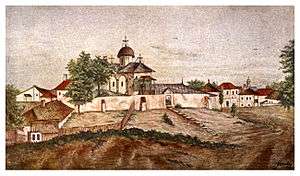Bucur (legendary shepherd)
Bucur is the legendary Romanian shepherd who is said to have founded Bucharest, giving its name to it. While the legend about the shepherd is probably apocryphal, the name of Bucureşti is quite likely derived from a person named Bucur, as the suffix -eşti is used for settlements derived from personal names, usually of the owner of the land or of the founder. It is more likely that Bucur was the noble who owned the land.

There is an old small church named Biserica lui Bucur ("Bucur's Church") which the legend says that it was built by Bucur, however, this is not true, as the church appears to have been built in the first part of 18th century and in the area, the oldest archeological remains found were from second half of the 16th century.[1]
The earliest reference to Bucur was written by the Franciscan monk Blasius Kleiner who claimed that Bucur was both a shepherd and a haiduc. Another early reference to Bucur was in An Account of the Principalities of Wallachia and Moldavia, an 1820 book published in London by the English consul in Bucharest, William Wilkinson. The earliest reference to Bucur's Church is from a geography manual written by Iosif Gentilie in 1835.[1]
The name is related with Romanian bucurie ("joy"), having a cognate in Albanian, bukur ("beautiful").[2] and it is believed to be of Dacian origin.[3]
There were various other etymologies given by early scholars, including the one of Ottoman traveler Evliya Çelebi, who said that Bucharest is named after a certain "Ebu-Kariş", from the tribe of "Beni-Kureiş". In 1781, I. Fr. Sulzer claimed that it's related to bucurie (joy), bucuros (joyful), a bucura (to become joyful), while an early 19th-century book published in Vienna assumed its name is derived from "Bukovie", a beech forest.[1]
See also
Notes
References
- Florian Georgescu et al. Istoria Oraşului Bucureşti, Muzeul de Istorie a Oraşului Bucureşti, 1965
- Alexandru Rosetti. Istoria limbii române, 2 vols., Bucharest, 1965-1969.